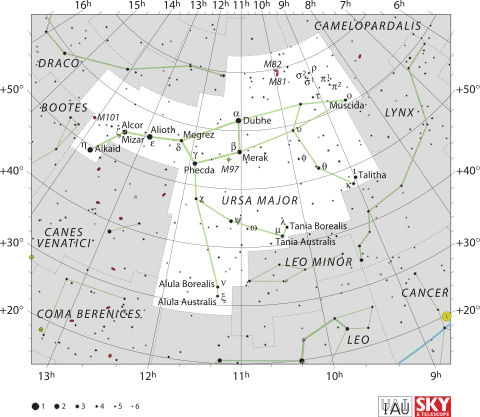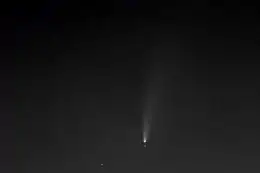Iota Ursae Majoris
Iota Ursae Majoris (ι Ursae Majoris, abbreviated Iota UMa, ι UMa), also named Talitha /ˈtælɪθə/,[10] is a star system in the northern circumpolar constellation of Ursa Major. It has an apparent visual magnitude of 3.14,[2] making it visible to the naked eye and placing it among the brighter members of this constellation. Based upon parallax measurements, it is located at a distance of 47.3 light-years (14.5 parsecs) from the Sun.
 Location of ι Ursae Majoris (circled) | |
| Observation data Epoch J2000 Equinox J2000 | |
|---|---|
| Constellation | Ursa Major |
| Right ascension | 08h 59m 12.45362s[1] |
| Declination | +48° 02′ 30.5741″[1] |
| Apparent magnitude (V) | 3.14[2]/10.1/10.3 |
| Characteristics | |
| Spectral type | F0IV-V + M3V + M4V[3] |
| U−B color index | +0.08[2] |
| B−V color index | +0.19[2] |
| Variable type | Suspected |
| Astrometry | |
| Radial velocity (Rv) | +9.0[4] km/s |
| Proper motion (μ) | RA: -441.29[1] mas/yr Dec.: -215.32[1] mas/yr |
| Parallax (π) | 68.92 ± 0.16 mas[1] |
| Distance | 47.3 ± 0.1 ly (14.51 ± 0.03 pc) |
| Absolute magnitude (MV) | +2.31[5] |
| Orbit[6] | |
| Primary | ι UMa A |
| Companion | ι UMa BC |
| Period (P) | 2084 ± 15 yr |
| Semi-major axis (a) | 16.7 ± 0.3″ |
| Eccentricity (e) | 0.90 ± 0.02 |
| Inclination (i) | 54 ± 4° |
| Longitude of the node (Ω) | 134 ± 2° |
| Periastron epoch (T) | B 2029 ± 1 |
| Argument of periastron (ω) (secondary) | 23 ± 5° |
| Details | |
| ι UMa A | |
| Mass | 1.7 ± 0.1 / 1.0 ± 0.3[3] M☉ |
| Luminosity | 9.87[5] L☉ |
| Surface gravity (log g) | 4.30 ± 0.07[3] cgs |
| Temperature | 7260 ± 70[3] K |
| Rotational velocity (v sin i) | 154[7] km/s |
| Age | 620[8] Myr |
| ι UMa B | |
| Mass | 0.35 ± 0.05[3] M☉ |
| ι UMa C | |
| Mass | 0.30 ± 0.05[3] M☉ |
| Other designations | |
| Database references | |
| SIMBAD | ι UMa |
| ι UMa A | |
| ι UMa BC | |
| ARICNS | ι UMa A |
| ι UMa B | |
| ι UMa C | |
Nomenclature
ι Ursae Majoris (Latinised to Iota Ursae Majoris) is the star's Bayer designation.

The traditional name Talitha, (which was shared with Kappa Ursae Majoris) comes from the Arabic phrase Al Fiḳrah al Thalitha (Arabic: الفقرة الثالثة), a mis-transcription of Al Ḳafzah al Thalitha (Arabic: القفزة الثالثة), which means "the third spring, or leap, of the ghazal".[11] The term Borealis meaning "the north side" in Latin. In 2016, the International Astronomical Union organized a Working Group on Star Names (WGSN)[12] to catalog and standardize proper names for stars. The WGSN's first bulletin of July 2016[13] included a table of the first two batches of names approved by the WGSN; which included Talitha for this star.
In Chinese, 三台 (Sān Tái), meaning Three Steps, refers to an asterism consisting of ι Ursae Majoris, Kappa Ursae Majoris, Lambda Ursae Majoris, Mu Ursae Majoris, Nu Ursae Majoris and Xi Ursae Majoris. Consequently, the Chinese name for ι Ursae Majoris itself is 上台一 (Shàng Tái yī, English: Star of First Upper Step).[14]
The star was also dubbed Dnoces ('Second,' backwards) after Edward H. White II, an Apollo 1 astronaut. The name was invented by his fellow astronaut Gus Grissom as a practical joke.[15]
Stellar system
The Iota Ursae Majoris system is composed of two sets of binary stars. The two binary systems orbit around each other once every 2,084 years.[3] The apparent separation between the two binaries is rapidly decreasing as they follow their orbits. In 1841 when the B component was first discovered, they had a separation of 10.7 arcseconds, or at least 156 AU. By 1971 their separation had decreased to 4.5 arcseconds, or at least 66 AU. This system appears to be dynamically unstable with a high likelihood and may become disrupted on a time scale on the order of 105 years.[16]
The brightest component is a white A-type subgiant. It is a member of a spectroscopic binary system whose components have an orbital period of 4,028 days. The companion, which has not been directly observed, is thought to be a white dwarf with a mass of 1.0 ± 0.3 M☉.[3]
The companion binary is composed of the 9th magnitude and 10th magnitude stars, both of which are red dwarfs.[3] These two red dwarfs, designated Iota Ursae Majoris B and C respectively, orbit around each other with a period of 39.7 years, and are separated by roughly 0.7 arcseconds, or at least 10 AU. This pair may be the source of the X-ray emission detected from this system.[17]
See also
- Gamma Velorum, informally named Regor for astronaut Roger B. Chaffee
- Gamma Cassiopeiae, informally named Navi for astronaut Virgil Ivan "Gus" Grissom
References
- van Leeuwen, F. (November 2007). "Validation of the new Hipparcos reduction". Astronomy and Astrophysics. 474 (2): 653–664. arXiv:0708.1752. Bibcode:2007A&A...474..653V. doi:10.1051/0004-6361:20078357. S2CID 18759600.
- Johnson, H. L.; et al. (1966). "UBVRIJKL photometry of the bright stars". Communications of the Lunar and Planetary Laboratory. 4 (99): 99. Bibcode:1966CoLPL...4...99J.
- Zhuchkov, R. Ya.; Malogolovets, E. V.; Kiyaeva, O. V.; Orlov, V. V.; Bikmaev, I. F.; Balega, Yu. Yu. (2012). "Physical parameters and dynamical properties of the multiple system ι UMa (ADS 7114)". Astronomy Reports. 56 (7): 512. Bibcode:2012ARep...56..512Z. doi:10.1134/S1063772912070074. S2CID 121681910.
- Evans, D. S. (June 20–24, 1966). "The Revision of the General Catalogue of Radial Velocities". In Batten, Alan Henry; Heard, John Frederick (eds.). Determination of Radial Velocities and their Applications. IAU Symposium no. 30. Vol. 30. University of Toronto: International Astronomical Union. p. 57. Bibcode:1967IAUS...30...57E.
- Anderson, E.; Francis, Ch. (2012), "XHIP: An extended hipparcos compilation", Astronomy Letters, 38 (5): 331, arXiv:1108.4971, Bibcode:2012AstL...38..331A, doi:10.1134/S1063773712050015, S2CID 119257644.
- "Sixth Catalog of Orbits of Visual Binary Stars". United States Naval Observatory. Archived from the original on 1 August 2017. Retrieved 16 May 2017.
- Royer, F.; Zorec, J.; Gómez, A. E. (February 2007), "Rotational velocities of A-type stars. III. Velocity distributions", Astronomy and Astrophysics, 463 (2): 671–682, arXiv:astro-ph/0610785, Bibcode:2007A&A...463..671R, doi:10.1051/0004-6361:20065224, S2CID 18475298
- Su, K. Y. L.; et al. (December 2006), "Debris Disk Evolution around A Stars", The Astrophysical Journal, 653 (1): 675–689, arXiv:astro-ph/0608563, Bibcode:2006ApJ...653..675S, doi:10.1086/508649, S2CID 14116473
- "iot UMa". SIMBAD. Centre de données astronomiques de Strasbourg. Retrieved 2012-02-25.
- "IAU Catalog of Star Names". Retrieved 28 July 2016.
- Richard Hinckley Allen :Star Names — Their Lore and Meaning - Ursa Major, the Greater Bear
- "IAU Working Group on Star Names (WGSN)". Retrieved 22 May 2016.
- "Bulletin of the IAU Working Group on Star Names, No. 1" (PDF). Retrieved 28 July 2016.
- (in Chinese) (Activities of Exhibition and Education in Astronomy) 天文教育資訊網 2006 年 6 月 21 日
- "Post-landing Activities", Apollo 15 Lunar Surface Journal, NASA. Commentary at 105:11:33.
- Zhuchkov, R. Ya.; Orlov, V. V.; Rubinov, A. V. (January 2006), "Dynamical stability of the quadruple systems HD 68255/6/7 and HD 76644", Astronomy Reports, 50 (1): 62–67, Bibcode:2006ARep...50...62Z, doi:10.1134/S1063772906010070, S2CID 121898143
- De Rosa, R. J.; et al. (July 2011), "The Volume-limited A-Star (VAST) survey - I. Companions and the unexpected X-ray detection of B6-A7 stars", Monthly Notices of the Royal Astronomical Society, 415 (1): 854–866, arXiv:1103.4363, Bibcode:2011MNRAS.415..854D, doi:10.1111/j.1365-2966.2011.18765.x, S2CID 84181878
External links
- NightSky Friday: Rotanev, Derf, Navi, and other Backward Star Names – Space.com article
- Talitha by Professor Jim Kaler.